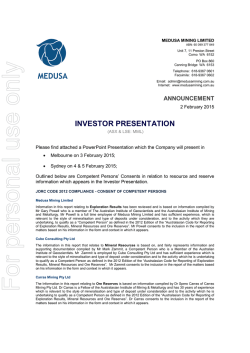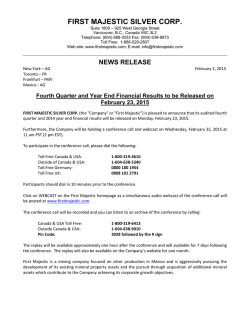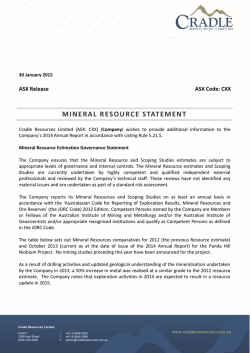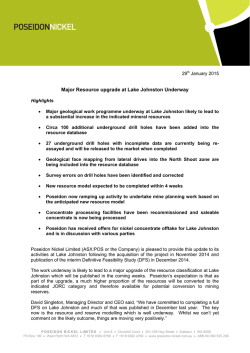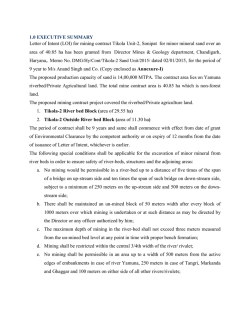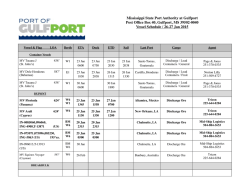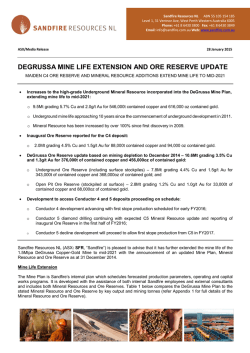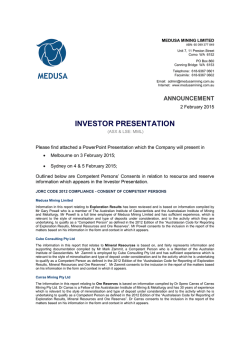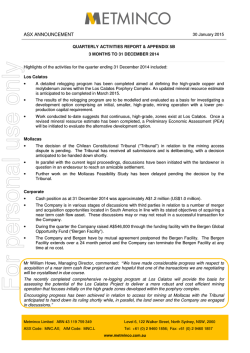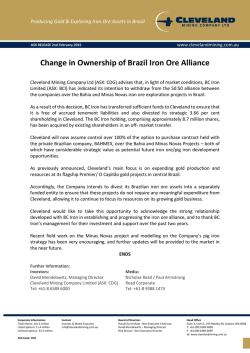
For personal use only - Australian Securities Exchange
Perth Office: Ascot Resources Ltd 512 Hay Street Subiaco WA 6008 T: + 61 8 9381 4534 F: + 61 8 9380 6440 E: [email protected] W: www.ascotresourcs.com For personal use only ASX ANNOUNCEMENT 2 February 2015 The Manager Company Announcements Office Australian Stock Exchange Limited Via: www.asxonline.com CLARIFICATION OF ORE RESERVE ESTIMATE FOR WONMUNNA IRON ORE PROJECT Ascot Resources Ltd (“Ascot” or “the Company”) refers to its announcement titled “Wonmunna Iron Ore Project – Maiden Ore Reserve Estimate” released to ASX on 6 January 2015 (“Ore Reserve Estimate Announcement”). A revised version of the Ore Reserve Estimate Announcement is attached (“Revised Announcement”). In accordance with Listing Rule 5.8.1, Ascot provides the following clarification in respect to the Ore Reserve Estimate Announcement: • Reference to the “further mineable tonnage estimate of 2.7Mt” derived from Inferred Resource inventory is omitted from the Revised Announcement. The omission of this information does not affect the Ore Reserve Estimate of 28.9Mt at a head grade of 58% in the Ore Reserve Estimate Announcement. • Sections 1, 2 and 3 of Table 1 of ASX Appendix 5A which were referenced in the Ore Reserve Estimate Announcement are attached in full in the Revised Announcement. • The material assumptions underpinning the PFS referred to in the Ore Reserve Estimate Announcement are set out in the Revised Announcement . For more information, visit www.ascotresources.com or contact: Paul Kopejtka Executive Chairman T: +61(0) 8 9381 4534 F: +61(0) 8 9380 6440 Andy Caruso Executive Director T: +61(0) 8 9381 4534 F: +61(0) 8 9380 6440 Ascot Resources Limited (ASX:AZQ) ABN 85 146 530 378 1 Perth Office: Ascot Resources Ltd 512 Hay Street Subiaco WA 6008 T: + 61 8 9381 4534 F: + 61 8 9380 6440 E: [email protected] W: www.ascotresourcs.com For personal use only ASX ANNOUNCEMENT 2 February 2015 The Manager Company Announcements Office Australian Stock Exchange Limited Via: www.asxonline.com WONMUNNA IRON ORE PROJECT – MAIDEN ORE RESERVE ESTIMATE KEY HIGHLIGHTS • Probable Ore Reserve estimate of 28.9 Mt at a head grade of 58% Fe for the Wonmunna Iron Ore Project in the Pilbara region of Western Australia • Based on a production rate of 5 Mtpa from Year 2 onwards, initial mine life expected to be in the order of 7 years • Ore Reserve estimate is derived from: o conversion of the existing Indicated Mineral Resource estimate (to a depth of c.50m) within the NMM and CMM deposits in accordance with JORC (2012) 1 o completion of a Pre-Feasibility Study (PFS) that assessed the delivery of DSO fines from Wonmunna to a delivery point to be agreed with a third party at or before Port Hedland o prevailing independent consensus estimates for iron ore pricing Ascot Resources Limited (Ascot or the Company) (ASX: AZQ) is pleased to report a maiden Probable Ore Reserve estimate in accordance with JORC (2012) guidelines for the Wonmunna Iron Ore Project (Wonmunna or the Project) of 28.9 million tonnes (Mt) @ 58% Fe. The Ore Reserve estimate is based on pit designs and mine schedules for the three initial mining areas at Wonmunna that contain Indicated Mineral Resource estimates (Table 1). 1 Table 1: Wonmunna Iron Ore Project - Ore Reserve estimate Deposit CMM NMM-East NMM-West Total Notes: 1. 2. JORC Ore Category Fe cut-off Tonnes (%) (Mt) Probable Probable Probable Probable 54.2 52.8 51.2 10.03 12.41 6.42 28.86 1 Fe CaFe SiO2 Al2O3 P LOI (%) (%) (%) (%) (%) (%) 58.0 58.0 58.0 58.0 63.5 63.1 63.9 63.4 4.99 5.29 4.37 4.98 2.94 3.10 2.75 2.97 0.10 0.07 0.09 0.09 8.76 8.20 9.36 8.65 Tonnes are dry metric tonnes and have been rounded. CaFe represents calcined Fe and is calculated by Ascot using the formula CaFe = Fe%/((100-LOI)/100) Refer Appendix 2 Ascot Resources Limited (ASX:AZQ) ABN 85 146 530 378 1 For personal use only The Ore Reserve originates from a Mineral Resource estimate of 84.3Mt (@ 50% Fe cut-off grade) (Table 2), which is a result of an extensive drilling programme in which over 1,200 holes were drilled for a total of 56,376 metres. Deposit NMM¹ Table 2: Mineral Resource Estimate (in accordance with JORC (2012)) JORC Minimum Fe Resource Fe SiO2 Al2O3 Category cut-off (Mt) (%) (%) (%) (%) Inferred Indicated CMM¹ Inferred Indicated SMM² Inferred EMM³ Inferred TOTAL Inferred & Indicated Notes: 1. 2. 3. 50 60 50 60 50 60 50 60 50 60 50 60 50 60 1.9 0.7 39.7 7.4 3.8 2.9 14.4 0.8 17.2 1.7 7.2 0.1 84.3 13.5 59.2 60.7 57.1 61.1 57.0 61.1 57.1 60.8 55.3 61.2 54.0 61.1 56.5 61.0 4.2 3.5 5.6 3.3 5.2 3.0 5.6 3.2 6.7 2.9 7.9 3.5 6.0 3.2 2.5 2.1 3.3 1.9 3.3 1.9 3.3 2.0 3.8 1.6 4.6 2.2 3.5 1.9 P (%) 0.08 0.08 0.08 0.08 0.11 0.11 0.10 0.11 0.07 0.06 0.08 0.08 0.08 0.09 LOI 8.8 7.1 8.7 7.0 9.3 7.4 9.0 7.3 9.7 7.6 9.5 7.9 9.1 7.2 Estimate provided by Coffey Mining in 2012 Estimate update provided by Quantitative Group 2012 Estimate by CSA Global 2012 Summary of Material Information The Wonmunna Project comprises four (4) deposits, NMM, CMM, SMM and EMM, covered by mining leases M47/1423-1425. The mining leases are contained within exploration licence (E47/1137) which covers an area of c. 230 square kms. All of the project tenements are beneficially owned by a wholly owned subsidiary of Ascot. The maiden Ore Reserve estimate is derived from the ‘Indicated Resource’ estimate within the larger Mineral Resource estimate for the NMM and CMM deposits. The total Indicated Mineral Resource estimate (@ 50% Fe Cut-off grade) for these deposits is 54.1Mt @ 57.1% Fe. The estimated ore tonnage is contained predominantly within the Mt Newman member of the Marra Mamba Iron Formation (MMIF), and therefore exhibits mineralogical characteristics that are similar to the orebody currently mined at the neighbouring West Angelas operation managed by Rio Tinto Iron Ore. Ascot proposes to develop a 5Mtpa Direct Shipping Ore (DSO) operation including all associated road and mining/processing infrastructure. Ascot’s proposed production schedule is for an initial 3Mtpa rate in year 1, ramping-up to a 5Mtpa operation by year 2 and beyond. Conventional open pit mining methods are proposed for all pits which are located within 5 km from the main processing area. The mine plan is based on pit designs which entail the extraction of ore above water table using typical drill and blast and load and haul practices with a blast bench height of 6m and a mining flitch height of 2m. Ascot Resources Limited (ASX:AZQ) 2 For personal use only Both the NMM and CMM deposits have generally simple geometry, with mineralised zones and boundaries that are clearly defined for the purposes of grade control and overall management of product quality. The proposed mine has a low stripping ratio of c.1.3 tonnes of waste per tonne of ore over the life of the mine 2. Ascot’s mine planning consultant, Orelogy, modelled dilution and mining ore loss by applying ‘edge effects’ and regularisation of the Mineral Resource block model. The dilution process involved ‘re-blocking’ to 6.25m x 6.25m x 2.0m for the Selective Mining Unit (SMU) size followed by applying additional block ‘edge effects’ using in-house algorithms. A variable cut-off grade policy between 52% Fe to 54% Fe was used to define ore, with material between 50% Fe and the pit cut-off to be stockpiled as a potential future low-grade product or for potential beneficiation. The cut-off grade is applied after dilution and is selected based primarily on achieving an ore product of 58% Fe with marketable chemical and physical characteristics. Ascot completed geotechnical drilling and studies in support of design parameters used to develop pit designs for selected ‘shells’ from mine optimisation studies. Ascot proposes to produce a nominal minus 8mm DSO fines product using a two-stage crushing and screening plant. Native Title Mining Agreements are in place with the two claimant groups whose claims affect the Project. Heritage Surveys have been completed for the proposed Project footprint, including all planned mining and infrastructure disturbance areas. An application under Section 18 of the Aboriginal Heritage Act (WA) to disturb potential sites has been made with the endorsement of both claimant groups. The Company has been granted a Native Vegetation Clearing Permit for the proposed Project footprint and submitted a Mining Proposal including closure plan to the Department of Mines and Petroleum (DMP) in November 2014. Final environmental and mining approvals required to implement the Project will be progressed after the anticipated approval of the Mining Proposal in early 2015. Ascot has a granted miscellaneous license (length 180m) for a haul road that will link the mining operation to a specified entry point onto the Great Northern Highway to allow quad road trucks to transport DSO product from Wonmunna to an agreed delivery point at or before Port Hedland. Ascot has advanced requirements in relation to gaining approval from the Mains Road Department for the design of the haul road and highway intersection obtaining a permit for the concessional loading and transportation of iron ore. Ascot is in advanced discussions with a third party in relation to a mine or port gate sale of DSO product at a delivery point to be agreed at or before Port Hedland. These discussions remain confidential and incomplete. Financial assumptions for mine optimisation and subsequent modelling for the Pre-Feasibility Study (PFS) are derived from contractor pricing, internal estimates and independent third parties. Assumptions for iron ore prices are based on consensus data released by leading investment houses in September 2014 for Platts 62% Fe CFR USD price which has been adjusted for the following: • • • Grade (62% Fe to 58% Fe) to reflect target product grade; Impurities adjustment (8%); and Moisture (8%) Exchange rates are based on consensus data released by leading investment houses in September 2014. 2 Strip Ratio excludes pre-stripping volumes of c.3.2Mt of waste to be undertaken in the period leading up to first production of ore. Ascot Resources Limited (ASX:AZQ) 3 For personal use only Average Life of mine (LOM) estimates for iron ore pricing metrics are as follows: • • • CFR USD 78.50 Exchange rate $0.84 FOB A$74 LOM estimates for average operating and capital costs are provided in Tables 3 and 4 below. Table 3: Average LOM Operating Costs ($/t FOB – C1) OPEX A$ per tonne Mining 10 Processing 5 Haulage 27 Port 11 General Administration 1 TOTAL 54 Table 4: Initial Capital Cost Estimate for 3Mtpa and subsequent expansion to 5Mtpa Capex A$m Prestrip 15.0 Camp 11.6 Road Haulage 3.0 Site Infrastructure 7.6 Contingency 3.8 Set up to 3mtpa 41.0 Upgrade to 5mtpa- Camp 10.0 Total Capex 51.0 Appendix 1 provides a pictorial representation of representative plans and sections for the three major mining areas – CMM, NMM-E and NMM-W. Appendix 2 provides a summary table for the Ore Reserve estimate in accordance with JORC (2012). Ascot’s Executive Chairman, Mr. Paul Kopejtka, commented on the maiden Ore Reserve estimate: “The maiden Ore Reserve is a major milestone for the Wonmunna Project and highlights the significant potential of this development as a supplier of high quality direct shipping iron ore to the North Asian market. Ascot continues to progress key approvals and a final product sales solution in order to position the Wonmunna Project for potential financing and execution in the future. The Ascot Board expects to consider options for financing the Project in Q1 2015.” Ascot Resources Limited (ASX:AZQ) 4 For personal use only For more information, visit www.ascotresources.com or contact: Paul Kopejtka Executive Chairman T: +61(0) 8 9381 4534 Andy Caruso Executive Director T: +61(0) 8 9381 4534 Competent Persons Statement The information in this report that relates to Exploration Results or Mineral Resources for the Wonmunna Project NMM and CMM deposits is based on, and fairly reflects, information compiled by Mr David Slater, who is a Chartered Professional Member of The Australasian Institute of Mining and Metallurgy and a Member of the Australian Institute of Geoscientists. Mr Slater is employed as Principal Resource Geologist by Coffey Mining. Mr Slater has sufficient experience that is relevant to the style of mineralisation and type of deposit under consideration and to the activity being undertaken to qualify as a Competent Person as defined in the 2012 Edition of the ‘Australasian Code for Reporting of Exploration Results, Mineral Resources and Ore Reserves’. Mr Slater consents to the inclusion in the report of the matters based on his information in the form and context in which it appears. The information in this report that relates to Exploration Results or Mineral Resources for the Wonmunna Project SMM and EMM deposits is based, and fairly reflects, information compiled by Mr Dmitry Pertel, who is a Member of the Australian Institute of Geoscientists. Mr Pertel is employed by CSA Global Pty Ltd, independent resource industry consultants. Mr Pertel has sufficient experience that is relevant to the style of mineralisation and type of deposit under consideration and to the activity which he is undertaking to qualify as a Competent Person as defined in the 2012 Edition of the “Australasian Code for Reporting of Exploration Results, Mineral Resources and Ore Reserves”. Mr Pertel consents to the inclusion in the report of the matters based on his information in the form and context in which it appears. The information in this report that relates to the Ore Reserve estimate is based on, and fairly represents, information which has been compiled by Mr Jake Fitzsimons who is an employee of Orelogy Group Pty Ltd and a Member of the Australasian Institute of Mining and Metallurgy. Mr Fitzsimons has sufficient experience that is relevant to the style of mineralisation and type of deposit under consideration and to the activity that is being undertaken to qualify as a Competent Person as defined in the 2012 Edition of the ‘Australasian Code for Reporting of Exploration Results, Mineral Resources and Ore Reserves’. Mr Fitzsimons consents to the inclusion in this report of the matters based on his information in the form and context in which they appear. Ascot Resources Limited (ASX:AZQ) 5 For personal use only Appendix 1 REPRESENTATIVE PLANS AND SECTIONS Ascot Resources Limited (ASX:AZQ) 6 For personal use only Figure 1: Pit Design and Representative Cross Section for CMM Deposit Ascot Resources Limited (ASX:AZQ) 7 For personal use only Figure 2: Pit Design and Representative Cross Section for NMM-E Deposit Ascot Resources Limited (ASX:AZQ) 8 For personal use only Ascot Resources Limited (ASX:AZQ) 9 For personal use only Figure 3: Pit Design and Representative Cross Section for NMM-W Deposit Ascot Resources Limited (ASX:AZQ) 10 Appendix 2 For personal use only WONMUNNA ORE RESERVE ESTIMATE (JORC 2012) Section 1 – Sampling Techniques and Data Criteria Sampling techniques Drilling techniques JORC Code Explanation Nature and quality of sampling (e.g., cut channels, random chips, or specific specialised industry standard measurement tools appropriate to the minerals under investigation, such as downhole gamma sondes, or handheld XRF instruments, etc.). These examples should not be taken as limiting the broad meaning of sampling. Include reference to measures taken to ensure sample representivity and the appropriate calibration of any measurement tools or systems used. Aspects of the determination of mineralisation that are Material to the Public Report. In cases where ‘industry standard’ work has been done this would be relatively simple (e.g., “reverse circulation drilling was used to obtain 1m samples from which 3kg was pulverised to produce a 30g charge for fire assay”). In other cases more explanation may be required, such as where there is coarse gold that has inherent sampling problems. Unusual commodities or mineralisation types (eg submarine nodules) may warrant disclosure of detailed information. Drill type (eg core, reverse circulation, openhole hammer, rotary air blast, auger, Bangka, sonic, etc) and details (eg core diameter, triple or standard tube, depth of diamond tails, face-sampling bit or other type, whether core is oriented and if so, by what method, etc). Ascot Resources Limited (ASX:AZQ) Commentary The Wonmunna NMM and CMM deposits were sampled using predominately Reverse Circulation (RC) and minor diamond drill holes (DD) on nominal 50m x 50m grid spacing. At NMM a total of 844 RC drill holes were drilled for 37,340m and a total 5 DD drill holes were drilled for 296m. At CMM a total of 213 RC drill holes were drilled for 9,495m and a total 1 DD drill holes were drilled for 61m. The DD was primarily used for metallurgy as well as twinning RC holes. Downhole logging (gamma, density, magnetic susceptibility and caliper log) was also undertaken. RC drilling samples were taken at consecutive 1m intervals down hole and cone split to approx. 2-3kg then dispatched for sample preparation at Kalassay Perth, Amdel Adelaide and ALS Perth. Diamond Drilling (DD) was undertaken. Core was transported to ALS laboratories in Perth and samples were taken for metallurgical analyses. (Note DD assay results were not used in Mineral Resource). All RC drilling was logged with recovery recorded and entered into a sampling database with standardised codes onsite soon as practically possible after the drill hole was completed. Vertical RC drilling (6 inch hole diameter) conducted with face-sampling drill bit. RC drilling accounts for 99.2% of the drilling database. RC drillhole depths range from 6m to 180m. DD utilised double tube HQ sized conventional drill tube on a multipurpose drilling rig. DD drill hole depths range from 44m to 87m. The average hole depth for NMM and CMM was 45m. 11 Section 1 – Sampling Techniques and Data Criteria For personal use only Drill sample recovery Logging Sub-sampling techniques and sample preparation JORC Code Explanation Method of recording and assessing core and chip sample recoveries and results assessed. Measures taken to maximise sample recovery and ensure representative nature of the samples. Whether a relationship exists between sample recovery and grade and whether sample bias may have occurred due to preferential loss/gain of fine/coarse material. Whether core and chip samples have been geologically and geotechnically logged to a level of detail to support appropriate Mineral Resource estimation, mining studies and metallurgical studies. Whether logging is qualitative or quantitative in nature. Core (or costean, channel, etc.) photography. The total length and percentage of the relevant intersections logged. If core, whether cut or sawn and whether quarter, half or all core taken. If non-core, whether riffled, tube sampled, rotary split, etc. and whether sampled wet or dry. For all sample types, the nature, quality and appropriateness of the sample preparation technique. Quality control procedures adopted for all sub-sampling stages to maximise representivity of samples. Measures taken to ensure that the sampling is representative of the in situ material collected, including for instance results for field duplicate/second-half sampling. Whether sample sizes are appropriate to the grain size of the material being sampled. Ascot Resources Limited (ASX:AZQ) Commentary RC samples recovery are reviewed and recorded at site then transferred to the database for each 2m interval with recoveries generally considered appropriate. Minor damp and wet drilling was recorded and drilling techniques adjusted (e.g., fluid injection) to ensure adequate recoveries. Diamond drilling recovery was recorded at site and recoveries were considered appropriate. No sample bias is considered evident for all phases of drilling. All RC drill holes, were geologically logged at a sample interval of 2m for lithology, colour, weathering, minerals, main particle size and general observations in standard company template using a standard code library. Logging was both qualitative (e.g. lithology description, colour and comments) and quantitative (e.g. grain size, porosity). The entire length of drill holes (100%) was logged Logging of the diamond drillholes included recording of lithological contacts, weathering contacts, and structural orientations, dry and wet core photography was undertaken. All core was logged in standard company template using a standard code library. Logging is of sufficient quality for mineral resource studies. Samples are split at the time of drilling through an integrated cone type splitter. Splitter is cleaned after each run. Laboratory sample preparation of RC drill samples from site is industry standard comprised drying, crushing to <2mm p70%, riffle split 250g, pulverize to 75micron p85% at industry accredited sample preparation facility. Field duplicates are inserted at a ratio of approximately 1 in 20. Standards are inserted at a ratio of approximately 1 in 20. Sample and particle sizes are appropriate for the target mineral (Fe). Core was composited in metallurgical dependent intervals and has not been used in resource estimation. Sampling techniques are considered sufficient to provide an adequately representative sample for assaying. 12 Section 1 – Sampling Techniques and Data Criteria For personal use only Quality of assay data and laboratory tests JORC Code Explanation The nature, quality and appropriateness of the assaying and laboratory procedures used and whether the technique is considered partial or total. For geophysical tools, spectrometers, handheld XRF instruments, etc., the parameters used in determining the analysis including instrument make and model, reading times, calibrations factors applied and their derivation, etc. Nature of quality control procedures adopted (e.g., standards, blanks, duplicates, external laboratory checks) and whether acceptable levels of accuracy (i.e., lack of bias) and precision have been established. Ascot Resources Limited (ASX:AZQ) Commentary Assay of RC samples by industry standard techniques performed by Kalassay, Perth Amdel (Adelaide) and ALS Geochemistry, Perth, Western Australia; 14 elements/oxides by XRF fusion , LOI1,000 by TGA furnace. Techniques are considered to represent total concentration. QAQC iron ore standards are inserted in drill hole sample sequences randomly at a ratio of approximately 1 in 20 prime samples; duplicates are inserted at a ratio of approximately 1 in 20 prime samples. The QAQC sample results are assessed from the certificated laboratory reports and show acceptable levels of accuracy and precision with respect to known values in the case of standards and the correlated duplicate and prime samples. The laboratory itself also conducts internal routine repeat assays. Coffey Mining has completed an independent review of the available QAQC data for the drill programs and determined that acceptable levels of accuracy and precision have been established 13 Section 1 – Sampling Techniques and Data Criteria For personal use only Verification of sampling and assaying Location of data points JORC Code Explanation The verification of significant intersections by either independent or alternative company personnel. The use of twinned holes. Documentation of primary data, data entry procedures, data verification, data storage (physical and electronic) protocols. Discuss any adjustment to assay data. Accuracy and quality of surveys used to locate drillholes (collar and down-hole surveys), trenches, mine workings and other locations used in Mineral Resource estimation. Specification of the grid system used. Quality and adequacy of topographic control. Ascot Resources Limited (ASX:AZQ) Commentary Coffey has checked the database against the assay and geological logs. Data is entered into industry standard relational database (Datashed) used by CSA Global. Data entry procedures include standard error and missing data checks; final entered data is checked by a geologist. Data storage is on a digital server with back-ups. No adjustments have been made to the assay data. A twin-hole program of 6 DD holes has been completed. The results compare globally geologically. David Slater conducted a site visit, during the RC drilling programme which was reviewed and concluded all RC drilling procedures were appropriate For the drilling phase, geological data is entered directly into a standard company template spreadsheet using a standard code library. The data is then compiled in a standardised relational database and validated. Assay data for the drilling is provided for resource estimation as an extract from the global ‘Datashed’ database to Coffey as .csv files and extracted through a query into the assay table, eliminating the chance of dataentry transcription errors. Spot checks are made validating against the laboratory certificates. The global database is managed by a specialised consultant CSA Global in Perth, Western Australia. Data extracted from the global ‘Datashed’ database has been provided to Coffey as *.csv files from CSA Global. Basic validation checks (e.g., looking for missing or overlapping intervals) were conducted by Coffey on the extracted data to ensure the resource database was internally consistent and contained no obvious errors. All of the available assay data with was used in the resource estimation. Drillhole collars are surveyed using DGPS by registered surveyor. Downhole surveys for the RC holes at time of drilling were not taken as holes are vertical and relatively shallow. The surface topography used in the resource is derived from a combination of a Fugro 2011 topographic survey and drillhole collars. The topography is adequate for use in the mineral resource estimate and has been considered in resource classification. 14 Section 1 – Sampling Techniques and Data Criteria For personal use only Data spacing and distribution Orientation of data in relation to geological structure JORC Code Explanation Data spacing for reporting of Exploration Results. Whether the data spacing and distribution is sufficient to establish the degree of geological and grade continuity appropriate for the Mineral Resource and Ore Reserve estimation procedure(s) and classifications applied. Whether sample compositing has been applied. Whether the orientation of sampling achieves unbiased sampling of possible structures and the extent to which this is known, considering the deposit type. If the relationship between the drilling orientation and the orientation of key mineralised structures is considered to have introduced a sampling bias, this should be assessed and reported if material. Commentary The drill holes are spaced on an approximate 50m by 50m E-W oriented grid with some closer spaced and overlapping drill holes. This is considered sufficient to establish the continuity of geology and mineralisation for the purposes of the Mineral Resource estimate. RC drilling was sampled at 1m intervals. These were composited to 2m interval at the drill site for assay. This sample interval is sufficient to map the geological and grade continuity for the mineral resource definition. Drill holes are drilled vertically being perpendicular to the formations- that host the iron mineralisation. Drill traverses oriented across-strike of mineralisation. The drilling has been oriented with a dip of 90° perpendicular to the mineralisation, which is considered acceptable to test the mineralisation Core holes were orientated at 70° to allow for structural logging of the core. Sample security The measures taken to ensure sample security. RC drill sampling supervised by site geologist. Site samples were packed in containers and sealed for transport/distribution to the laboratories. Audits or reviews The results of any audits or reviews of sampling techniques and data. The Company’s RC drilling and assay procedures were independently reviewed by Coffey as part of the field visits by Coffey. The sampling techniques were reviewed and found to be of sufficient quality and appropriate for this type of deposit to be used in Mineral Resource estimation. Ascot Resources Limited (ASX:AZQ) 15 Section 2 – Reporting of Exploration Results Criteria For personal use only Mineral tenement and land tenure status Exploration done by other parties JORC Code Explanation Type, reference name/number, location and ownership including agreements or material issues with third parties such as joint ventures, partnerships, overriding royalties, native title interests, historical sites, wilderness or national park and environmental settings. The security of the tenure held at the time of reporting along with any known impediments to obtaining a licence to operate in the area. Acknowledgment and appraisal of exploration by other parties. Ascot Resources Limited (ASX:AZQ) Commentary The tenements consist of Exploration License E47/1137 granted on 29/08/2002 and Mining Leases M47/1523 (CMM), M47/1424 (NMM) and M47/1245 granted on 30/04/2012. Ochre Group Holdings Limited (OGH)previously called Rico Resources - entered into an “Option Sale of Mining Tenements Agreement ” with Talisman on 1 October 2010 under which OGH acquired an option to obtain a 100% interest in the tenements. OGH exercised the option and completed the acquisition. OGH has not yet paid the stamp duty outstanding on the acquisition of the tenements and as such has not yet registered a transfer in respect of the tenements. It is however the beneficial owner of a 100% interest in the tenements. As part of the Agreement, OGH granted 1% of gross royalty from all products from the tenements payable to Talisman. Previous exploration carried out by other parties included: Western Mining (1967-1975) – Regional exploration for copper. Forsyth NL (1989) - Regional exploration for gold. Talisman Mining Ltd 2005-2008 Regional exploration for base metals. Talisman Mining Ltd 2009 Drilling of Marra Mamba formation for Fe. Initial Inferred Mineral resource quoted. Rico Resources Ltd. 2010-2012 Follow up infill and extensional drilling and evaluation. 16 Section 2 – Reporting of Exploration Results Criteria For personal use only Geology JORC Code Explanation Deposit type, geological setting and style of mineralisation. Ascot Resources Limited (ASX:AZQ) Commentary At NMM the geology mapping shows relatively poor outcrop in the east (alluvial/CID cover forming a well preserved Hamersley Surface – i.e., laterite cover), with more Marra Mamba Iron Formation (MMIF) outcrop in the western third of the 5km long mineralisation trend. From examination of the present NMM drill and gamma logs the full sequence of MMIF appears to be present (i.e., Nammuldi Member to Mt Newman Member, together with some West Angela Member of the overlying Wittenoom Formation). The high grade mineralisation is located within the Mt Newman Member. NMM appears to be a gently folded, upright open synclinal structure “daylighting” at both the eastern and western ends, as seen locally and highlighted by the dolerite sills of the surrounding Jeerinah Formation in the local area. The steeper dips as mapped and as seen in some of the North core are suggested to simply reflect meso-scale folds within the overall “flat”, gently folded structural envelope. At CMM there is no bedrock MMIF outcrop along the c.2km long mineralisation trend, as it is covered by a Hamersley Surface developed on a CID sequence. The CID cover is of variable thickness, but up to 10m thick, but is very weathered. Underlying the CID is alluvial white clay which is potentially in excess of 30m thick lying in a deep channel along the north side of the deposit from ~ 705300E eastwards. At the CMM deposit, there is no detailed understanding of what the structure (or stratigraphic detail) of the area at this time, given total lack of exposure and the fact that some drill holes have finished in mineralisation. Extra drilling is necessary to close off mineralisation and provide more structural-stratigraphic data. As for NMM, it is probable that the mineralisation is developed in the Mount Newman Member. In the western section of the deposit, the structure is interpreted as flat lying. A fault appears to terminate mineralisation to the south. There is high grade mineralisation from ~704 600E t0 705 600E –which appears to be hosted within the Mount Newman Member stratigraphy. The high grade mineralisation has some internal shale-siliceous horizons within it, giving a more ‘patchy’ appearance compared to the NMM Mt Newman Member mineralisation. 17 Section 2 – Reporting of Exploration Results Criteria For personal use only Drillhole Information Data aggregation methods Relationship between mineralisation widths and intercept lengths Diagrams JORC Code Explanation A summary of all information material to the understanding of the exploration results including a tabulation of the following information for all Material drillholes: easting and northing of the drillhole collar elevation or RL (Reduced Level – elevation above sea level in metres) of the drillhole collar dip and azimuth of the hole downhole length and interception depth hole length If the exclusion of this information is justified on the basis that the information is not Material and this exclusion does not detract from the understanding of the report, the Competent Person should clearly explain why this is the case. Commentary As outlined in Section 1 of this table, at NMM a total of 844 RC drill holes were drilled for 37,340m and a total 5 DD drill holes were drilled for 296m. At CMM a total of 213 RC drill holes were drilled for 9,495m and 1 DD drill hole was drilled for 61m, at the Project dating back to 2009, forming the basis for the Mineral Resource estimate outlined in Section 3 of this Table. Material drill results for the Wonmunna Project have previously been announced to the market as required under the reporting rules defined by the JORC Code (2004) and the ASX Listing Rules. All material exploration results relevant to the Wonmunna Project area have been considered in establishing the Mineral Resource discussed in Section 3. Going forward any new exploration results that result in a material change to the existing Mineral Resource in section 3 will be updated as required under JORC Code 2012 and current ASX Listing Rules. Drillhole collar plans and cross sections are provided in Figures 3 to 7 of this announcement. In reporting Exploration Results, weighting averaging techniques, maximum and/or minimum grade truncations (eg cutting of high grades) and cut-off grades are usually Material and should be stated. Where aggregate intercepts incorporate short lengths of high grade results and longer lengths of low grade results, the procedure used for such aggregation should be stated and some typical examples of such aggregations should be shown in detail. The assumptions used for any reporting of metal equivalent values should be clearly stated. No material changes to exploration or drillhole intercepts are stated in the ASX announcement. This statement relates to a Mineral Resource only. These relationships are particularly important in the reporting of Exploration Results. If the geometry of the mineralisation with respect to the drillhole angle is known, its nature should be reported. If it is not known and only the downhole lengths are reported, there should be a clear statement to this effect (eg ‘downhole length, true width not known’). No material changes to exploration or drillhole intercepts are stated in the ASX announcement. This statement relates to a Mineral Resource only. Appropriate maps and sections (with scales) and tabulations of intercepts should be included for any significant discovery being reported These should include, but not be limited to a plan view of drillhole collar locations and appropriate sectional views. No material changes to exploration or drillhole intercepts are stated in the ASX announcement. This statement relates to a Mineral Resource only. A drillhole plan and typical cross section are provided in Figures 3 to Figure 7 respectively of this announcement. Ascot Resources Limited (ASX:AZQ) 18 Section 2 – Reporting of Exploration Results Criteria For personal use only Balanced reporting JORC Code Explanation Where comprehensive reporting of all Exploration Results is not practicable, representative reporting of both low and high grades and/or widths should be practiced to avoid misleading reporting of Exploration Results. Commentary No material changes to exploration or drillhole intercepts are stated in the ASX announcement. This statement relates to a Mineral Resource only. Other substantive exploration data Other exploration data, if meaningful and material, should be reported including (but not limited to): geological observations; geophysical survey results; geochemical survey results; bulk samples – size and method of treatment; metallurgical test results; bulk density, groundwater, geotechnical and rock characteristics; potential deleterious or contaminating substances. No material changes to exploration or drillhole intercepts are stated in the ASX announcement. This statement relates to a Mineral Resource only. Further work The nature and scale of planned further work (e.g., tests for lateral extensions or depth extensions or large-scale step-out drilling). Diagrams clearly highlighting the areas of possible extensions, including the main geological interpretations and future drilling areas, provided this information is not commercially sensitive. This Mineral Resource is to be incorporated into a proposed Pre-Feasibility Study and will incorporate detailed mine planning. The Company plans to carry out a further staged exploration programme in the area undertaking geotechnical and sterilisation drilling, some additional metallurgical sampling and testing, as well as field and technical studies. The aim will be to have a Pre-Feasibility study completed by end of 2014 with the work programme matched to future project and mine planning requirements. Ascot Resources Limited (ASX:AZQ) 19 Section 3 – Estimation and Reporting of Mineral Resources Criteria For personal use only Database integrity Site visits Geological interpretation Dimensions JORC Code Explanation Measures taken to ensure that data has not been corrupted by, for example, transcription or keying errors, between its initial collection and its use for Mineral Resource estimation purposes. Data validation procedures used. Commentary The 2012 data collection was directly input into company standardized logging spreadsheets. Entry of assay data into the database was through direction extraction via a database query from the laboratory files. Checks have been conducted on aspects of the data entry by consultant CSA Global using their software and checked by Coffey. Data is stored in a single relational database ‘Datashed’. Coffey has conducted its own validation process on the data, with checks looking for missing/overlapping intervals, missing data, extreme values. No material issues were noted. Comment on any site visits undertaken by the Competent Person and the outcome of those visits. If no site visits have been undertaken indicate why this is the case. David Slater has visited the project on two separate occasions in 2012 reviewing data and geology during and post the RC drilling programme. All RC drilling procedures were considered industry standard and data collection methods appropriate. Confidence in (or conversely, the uncertainty of) the geological interpretation of the mineral deposit. Nature of the data used and of any assumptions made. The effect, if any, of alternative interpretations on Mineral Resource estimation. The use of geology in guiding and controlling Mineral Resource estimation. The factors affecting continuity both of grade and geology. Confidence in the geological model is high due to the similarity between the results of the drilling and project scale mapping. The understanding of the orientation of the geology trends and geological controls from mapping and resource drilling have been used to support the mineralisation interpretations used in the Mineral Resource estimate. The current geological and mineralisation interpretation NMM/CMM and the associated controls are considered robust and suitable for resource estimation. The extent and variability of the Mineral Resource expressed as length (along strike or otherwise), plan width, and depth below surface to the upper and lower limits of the Mineral Resource. The block model at NMM extends 5100m (EW), 2000m (N-S) and 200m (vertical). The block model at CMM extends 2000m (E-W), 600m (N-S) and 200m (vertical). Note that mineralisation is modelled for a maximum vertical extent of ~60m below surface. Ascot Resources Limited (ASX:AZQ) 20 Section 3 – Estimation and Reporting of Mineral Resources Criteria For personal use only Estimation and modelling techniques JORC Code Explanation The nature and appropriateness of the estimation technique(s) applied and key assumptions, including treatment of extreme grade values, domaining, interpolation parameters and maximum distance of extrapolation from data points. If a computer assisted estimation method was chosen include a description of computer software and parameters used. The availability of check estimates, previous estimates and/or mine production records and whether the Mineral Resource estimate takes appropriate account of such data. The assumptions made regarding recovery of by-products. Estimation of deleterious elements or other non-grade variables of economic significance (e.g., sulphur for acid mine drainage characterisation). In the case of block model interpolation, the block size in relation to the average sample spacing and the search employed. Any assumptions behind modelling of selective mining units. Any assumptions about correlation between variables. Description of how the geological interpretation was used to control the resource estimates. Discussion of basis for using or not using grade cutting or capping. The process of validation, the checking process used, the comparison of model data to drillhole data, and use of reconciliation data if available. Commentary The Mineral Resource was estimated using Ordinary Kriging techniques in Vulcan mining software. Search parameters were based on variography carried out on the 2m composites and supported by geological knowledge gained from field mapping and drillhole data. The Mineral Resource estimate was compared with the previous, QG 2009 Mineral Resource estimate, with the differences being accounted for by extensional, infill and deeper drilling, and improved understanding of the geology and mineralisation after the 2012 field work. The primary commodity considered in the Mineral Resource estimation is Fe. A full suite of elements was also estimated (SiO2, Al2O3, P, LOI, CaO, K2O, MgO, Mn, Na2O, S, TiO2 ) with some known as deleterious such as P, SiO2 and Al2O3. The parent block size of 25m(X) x 12.5m(Y) x 4m(Z) has been decided upon taking the drill hole spacing into account, as have the search parameters. The geological/mineralisation interpretation was developed using hard boundaries (wireframes). Selective mining units were not defined or corrected for in the resource estimate however a bulk open pit mining scenario using large excavators was considered in selection of the parent block size. The Mineral Resource estimate was validated through comparison of input and estimated grades visually and statistically. The estimate was also validated by looking at number of holes and samples used, average distance to informing samples, slope of regression and other statistical checks. Moisture Whether the tonnages are estimated on a dry basis or with natural moisture, and the method of determination of the moisture content. Tonnages are based on in-situ dry bulk density measurements. Cut-off parameters The basis of the adopted cut-off grade(s) or quality parameters applied. A nominal reporting cut-off grade of 50% Fe has been chosen. Further work via mining studies is required to further define an economic cut-off. Ascot Resources Limited (ASX:AZQ) 21 Section 3 – Estimation and Reporting of Mineral Resources For personal use only Criteria Mining factors or assumptions Metallurgical factors or assumptions JORC Code Explanation Assumptions made regarding possible mining methods, minimum mining dimensions and internal (or, if applicable, external) mining dilution. It is always necessary as part of the process of determining reasonable prospects for eventual economic extraction to consider potential mining methods, but the assumptions made regarding mining methods and parameters when estimating Mineral Resources may not always be rigorous. Where this is the case, this should be reported with an explanation of the basis of the mining assumptions made. The basis for assumptions or predictions regarding metallurgical amenability. It is always necessary as part of the process of determining reasonable prospects for eventual economic extraction to consider potential metallurgical methods, but the assumptions regarding metallurgical treatment processes and parameters made when reporting Mineral Resources may not always be rigorous. Where this is the case, this should be reported with an explanation of the basis of the metallurgical assumptions made. Commentary Selective mining units were not defined or corrected for in the resource estimate or a recoverable resource estimated. However a bulk open pit mining scenario such as using large (200t) excavators was considered and reflected in the block model construction and estimation parameters developed. Coffey was provided with three Mineral Engineering Technical Services Pty. Ltd. (METS) Metallurgy reports; ‘Metallurgical Testwork Report’J364-002 dated 18 November 2008; ‘Phase 2 Metallurgical Testwork Report’J364-003 dated April 2009; ‘Phase 3 Metallurgical Testwork Report’J364-004 dated June 2009. Reports investigated differing Wonmunna mineralisation types. The reports indicate material considered to be higher grade Marra Mamba mineralisation could be considered as a saleable DSO product. Blending of material however may be required. It is currently considered that mined material could be crushed and screened. Coffey notes further detailed metallurgical testwork is required. Environmental factors or assumptions Assumptions made regarding possible waste and process residue disposal options. It is always necessary as part of the process of determining reasonable prospects for eventual economic extraction to consider the potential environmental impacts of the mining and processing operation. While at this stage the determination of potential environmental impacts, particularly for a greenfield project, may not always be well advanced, the status of early consideration of these potential environmental impacts should be reported. Where these aspects have not been considered this should be reported with an explanation of the environmental assumptions made. Baseline environmental data has been collected. Coffey was provided with baseline environmental reports ‘Level 2 short-range endemic invertebrate fauna survey for the Wonmunna Iron Ore Project’ by Phoenix Environmental Services and ‘Flora and Vegetation Survey of the Wonmunna Area Level 2’ by G and G Environmental Pty. Ltd. No detailed assumption regarding possible waste and process residue disposal option sites have been made at this early stage of the project. It is not anticipated that environmental factors will be considered a material constraint to the prospects of eventual economic extraction. Bulk density Whether assumed or determined. If assumed, the basis for the assumptions. If determined, the method used, whether wet or dry, the frequency of the measurements, the nature, size and representativeness of the samples. The bulk density for bulk material must have been measured by methods that adequately account for void spaces (vugs, porosity, etc.), moisture and differences between rock and alteration zones within the deposit. In situ dry bulk densities (IDBD) were assigned on the basis of measurements collected from the drill core using a combination of ‘Archimedes principle weight in water’ technique from 30 core billets and downhole geophysical data from 450 drillholes. The average IDBD values applied to the 3 mineralised zones was; 2.71t/m hardcap, 3 3 2.51t/m CID and 2.81t/m to the primary Ascot Resources Limited (ASX:AZQ) 22 Section 3 – Estimation and Reporting of Mineral Resources Criteria For personal use only Classification JORC Code Explanation Discuss assumptions for bulk density estimates used in the evaluation process of the different materials. The basis for the classification of the Mineral Resources into varying confidence categories. Whether appropriate account has been taken of all relevant factors (ie relative confidence in tonnage/grade estimations, reliability of input data, confidence in continuity of geology and metal values, quality, quantity and distribution of the data). Whether the result appropriately reflects the Competent Person’s view of the deposit. Commentary mineralised horizon for both NMM and CMM. The applied values compare with typical values obtained at other Pilbara sites mining Marra Mamba ores. Mineral Resource classification was developed from the confidence levels of key criteria including topography, drilling methods, geological understanding and interpretation, sampling, data density and location, grade estimation and quality of the estimates. The area of Indicated Resource and Inferred Mineral Resource is considered appropriately informed and estimated for the classification. The resulting Mineral Resource estimate provides an appropriate global representation of this deposit in the view of the Competent Person. Audits or reviews The results of any audits or reviews of Mineral Resource estimates. The 2012 Mineral Resource estimate for NMM and CMM was completed by Coffey. No independent audit of the Mineral Resource has been undertaken. Discussion of relative accuracy/ confidence Where appropriate a statement of the relative accuracy and confidence level in the Mineral Resource estimate using an approach or procedure deemed appropriate by the Competent Person. For example, the application of statistical or geostatistical procedures to quantify the relative accuracy of the resource within stated confidence limits, or, if such an approach is not deemed appropriate, a qualitative discussion of the factors that could affect the relative accuracy and confidence of the estimate. The statement should specify whether it relates to global or local estimates, and, if local, state the relevant tonnages, which should be relevant to technical and economic evaluation. Documentation should include assumptions made and the procedures used. These statements of relative accuracy and confidence of the estimate should be compared with production data, where available. The Mineral Resource has been classified as a combination of Indicated and Inferred material. The resource estimate of grade and tonnage is based on the assumption that standard open cut mining methods will be applied and that high confidence grade control (e.g., dedicated RC grade control drilling) will be available for final ore-waste delineation. The Mineral Resource estimate is based on a realistic parent cell size and should be considered a global resource estimate, not a recoverable resource estimate based on SMU block size. The relative accuracy and confidence of the Mineral Resource estimate is inherent in the Mineral Resource Classification as coded in the block model; no mine production data is available at this stage for comparative purposes. Ascot Resources Limited (ASX:AZQ) 23 Section 4 – Estimation & Reporting of Ore Reserves • Site visits • The competent person for this Ore Reserve Statement is a full time employee of Orelogy Group Pty Ltd. The Project is a greenfield site. An employee of Orelogy conducted a site visit on 12 December 2014 on behalf of the competent person. Site visit included inspection of drill core, the topography site access and investigation of the potential locations of services for mining. Study status • A Pre-Feasibility Study (PFS) has been completed, and Ascot expects to update all documentation in the study by the end of Q1 CY15. Ascot is confident that the study will determine the Project to be technically achievable and economically viable Cut-off parameters • • The mine optimisation work applied an initial cut-off grade of 50% Fe. The cut-off grade required to achieve the required product grade of 58% Fe varies for each pit and was determined without any processing upgrade of the run of mine ore. For NMM-West a cut-off of 51.2% Fe is required, for NMM-East a cut-off grade of 52.8% is required and for CMM a cut-off grade of 54.2% is required in order to achieve the product specification. Mining factors or assumptions • The method used to convert Mineral Resources to Ore Reserves used pit optimisation studies to identify the economic shell within which a design process is applied to achieve a practical mine design for operability and scheduling. The assumed iron ore price and exchange rates used in the pit optimisation are derived from the average of three external forecasting analysts. For reasons of commercial sensitivity the assumed iron ore price and exchange rates are not disclosed. The price calculations include deductions for deleterious elements, Native Title and State Royalties and transport costs to China. Mining costs used in pit optimisation is derived from contractor estimates and verified against similar projects. Ore costs used in pit optimisation includes contractor and internal estimates for: Processing costs based on 2 stage crushing and screening, General & Administration overheads, Grade Control, road-train haulage and port charges. Water table data is coded into the models, all material below the water table is excluded from mining and processing. The mining footprint is limited to within the mining lease and excludes a buffer zone around the Weeli Wolli creek line. The mining method is based on conventional open cut operations using drill and blast, with load and haul using an excavator and rear dump trucks. This is considered to be appropriate for the style of mineralisation and is applied to similar operations in the Pilbara. Overall slope angles of 45 degrees is assumed based on pit depth and other operations in the area. Pit optimisation analysis studies did not show any sensitivities to changes in slope angle. For personal use only Mineral Resource estimate for conversion to Ore Reserves • • • • • • • • The Indicated Mineral Resources used for conversion to Ore Reserves are in respect to the Wonmunna Iron Ore Project, and specifically related to the NMM and CMM deposits. A technical description of the Mineral Resource estimate in accordance with JORC (2012) has previously been presented by Ascot Resources in ASX announcements relating to the acquisition of the Wonmunna Iron Ore Project (refer ASX announcement dated 18 March 2014). The Ore Reserve estimate is contained within the Indicated Mineral Resource estimate Ascot Resources Limited (ASX:AZQ) 24 For personal use only • Metallurgical factors or assumptions Environmental Infrastructure • • • • • • • • • • • • • • • The pit design process is based on 60 degree batters to 20m depth and 65 degree batters below 20m on the north, east and west walls. The slope parameters for the south walls is based on 55 degrees to 20m, 60 degrees to 40m and 65 degrees below 40m. The berm widths is 6m throughout for 12m bench heights. A 10% gradient and 25m width (including safety windrow) is used in pit ramps. A 40m minimum mining width is applied on all benches except goodbye cuts which are limited to a maximum of 6m in depth. Dilution and ore loss allowances are based on reblocking to 6.25m x 6.25m x 2.0m for the Selective Mining Unit (SMU) size followed by additional block edge effects applied using in-house scripts in two passes. The first pass is applied to all blocks to represent mixing from blasting practices and second pass is applied to the edge of the ore zones to represent grade control ore and waste delineation practices. Inferred Mineral Resource is effectively treated as waste in the Ore Reserves calculation process. The major infrastructure required for the Wonmunna Project includes: o Modular crushing and screening plant capable of processing up to 5Mtpa; o Mining camp with capacity for up to 420 persons (inc. managerial and administration staff); o Mine site access road, pit access ramps, ROM Pad and crusher area, processing plant, stockpile areas, product stockpiling and load out yard, waste dumps, tailing storage facility, mine operations centre, contractors laydown yards, explosives storage and camp. Metallurgical information is based on test work that used 290m of drill core from the NMM and CMM deposits. The metallurgical drilling coverage is sufficient for the project at PFS level. Analysis and process design of the project was completed by CSA Global and other external engineering vendors. The metallurgical interpretation and design supports a reasonable project proposal. The current project processing route is a dry 2-stage crush and screen to produce a -8mm product. This type of technology is well known and has precedence in current Pilbara iron ore operations. Modifying factors are applied at Reserve level, and the project strategy produces a single product without any associated upgrading. Environmental studies including flora, fauna and native vegetation are complete. Areas for waste dumps and rehabilitation strategies have been developed during submission of the Mining Proposal. Management strategies for Potentially Acid Forming (PAF) material have been contemplated in the Mining Proposal. Ascot has been granted a Native Vegetation Clearing Permit for the proposed Project footprint and submitted a Mining Proposal including closure plan to the Department of Mines and Petroleum (DMP) in November 2014. Final environmental and mining approvals required to implement the Project will be progressed after the anticipated approval of the Mining Proposal in early 2015. The site will be accessed directly from the Great Northern Highway via a 700mlong sealed road to be constructed as a part of site works. Ascot will also construct a suitable intersection as well as acceleration and slip lanes parallel to the Great Northern Highway in accordance with MRD Guidelines to allow for safe entry and exit of quad trucks All other infrastructure required for the operation will be constructed as part of the Ascot Resources Limited (ASX:AZQ) 25 For personal use only • Costs Revenue Factors Market Assessment Economic • • • • • • • • • • • • • Project. Sufficient land area has been allocated within the leases held by the Company. The major infrastructure required for the Wonmunna Project includes: o A sealed access road from the Great Northern Highway into the Wonmunna Project; and o Main site access road, pit access ramps, ROM Pad and crusher area, processing plant, stockpile areas, product stockpiling and load out yard, waste dumps, tailing storage facility, mine operations centre, contractors laydown yards, explosives storage and camp, general administration and other service facilities. The projected capital costs for the project have been compiled through estimates developed by Ascot in collaboration with experienced external consultants. The estimation process includes the design and cost estimation of plant and infrastructure to a PFS standard. The mining and processing costs are estimated by Ascot on the basis of having received tender quotes from external service providers and have been benchmarked against other operations in the Pilbara. The mining cost estimates include provision for recovery of equipment capital costs, all operating costs and contractor margin. Exchange rate assumptions are based on long term consensus forecasts from independent analysts. Transport charges are based on an internal logistics operation managed by Ascot and assume road haulage only. Allowances for royalties are based upon state agreements and contractual agreements with traditional landowners. Benchmarking against other Pilbara operations has confirmed confidence in the operating and capital cost estimates. Estimates are deemed to be at a PFS level of confidence. Forecast sales prices and exchange rates are based on the average of consensus market forecasts. For reasons of commercial sensitivity the assumed iron ore price and exchange rates are not disclosed. In generating the sales price applicable to the Wonmunna product, the sales price is discounted by: o Fe% grade of the Wonmunna product; o A discount for the quantity of deleterious elements for the normal Wonmunna product; o Moisture Content; and o Sea Freight costs. Established external forecast analysts have provided guidance to assess the long term market and sales of iron ore. Ascot Resources does not have any sales or off-take agreements in place. The financial modelling indicates that Wonmunna will produce a positive NPV at the required discount rate of 10% applied to real post-tax cashflows. Sensitivity analysis indicates that Projects economics remain secure within typical sensitivity ranges of operating cost, capital cost, iron ore prices and foreign exchange rates. Ascot Resources Limited (ASX:AZQ) 26 Native Title and Heritage • For personal use only • Other Classification • • • • • • • • Native Title Mining Agreements are in place with the two claimant groups (Ngarlawangga and Nyiyaparli #3) and are on fundamentally the same terms. Heritage Surveys have been completed for the proposed Project footprint, including all planned mining and infrastructure disturbance areas. An application under Section 18 of the Aboriginal Heritage Act (WA) to disturb potential sites has been made with the endorsement of both claimant groups. The Mining Leases are not contained within Pastoral Leases and are on Crown land All relevant government agreements and processes are proceeding and no factors are present to suggest approvals will not be forthcoming within the development schedule of the project. Mining Leases have been granted. Confidential discussions pertaining to third-party infrastructure access negotiations are progressing. Ore Reserves are based upon material classified as Indicated from the Mineral Resource estimation modelling. The Indicated Mineral Resource within the designed pits has been respectively converted to Probable Ore Reserves. The Ore Reserve classification results appropriately reflect the Competent Person’s view of the deposits. No Proven Ore Reserves have been derived from the Mineral Resource estimate. Audits reviews • According to Orelogy Group Pty Ltd, the procedures used to prepare the Ore Reserve estimates are in line with industry standards. Discussion of relative accuracy/confidence • The Ore Reserve estimates have been completed to a minimum of a PFS level of confidence. Bench marking of many mining parameters and costs have been undertaken against current and previous operational data from other sites in the Pilbara. The accuracy of the estimates will be subject to regular reconciliation and ongoing monitoring. • • Ascot Resources Limited (ASX:AZQ) 27
© Copyright 2026
